
Ready to break records
With an ear-splitting roar, the car’s wheels begin to turn, slowly at first, but within seconds all that is visible of the £30 million vehicle is the flame spitting from its exhaust in the distance.
The test run is over almost too quickly, but this was the fastest and furthest the Bloodhound Supersonic Car (SSC) has travelled so far. It marks a small but significant step towards the goal of turning it into the fastest vehicle to ever drive on land.
The British team behind the car is attempting to break a land speed record that has stood for more than 20 years. That record was set when Royal Air Force (RAF) pilot Andy Green hurtled across Black Rock Desert in Nevada, USA, at 1,227 kilometres per hour (kph) in 1997. On that occasion, he was sat behind the wheel of another British-built, jet-powered car called Thrust SSC, and he will now try to break his own record in Bloodhound.
Designed and built by a dedicated team of engineers, the pencil-shaped car is intended to do something that only military jets and Concorde have done before: travel at more than 1,600 kph
Designed and built by a dedicated team of engineers, the pencil-shaped car is intended to do something that only military jets and Concorde have done before: travel at more than 1,600 kph.
In a series of brief trips down the 2.7 kilometres of the runway at Aerohub, Cornwall Airport Newquay, in October 2017, the car was driven up to 305 kph. Then on 26 October, in front of thousands of members of the public, Bloodhound was taken above 320 kph for the first time, marking a major milestone on the journey towards breaking the record.
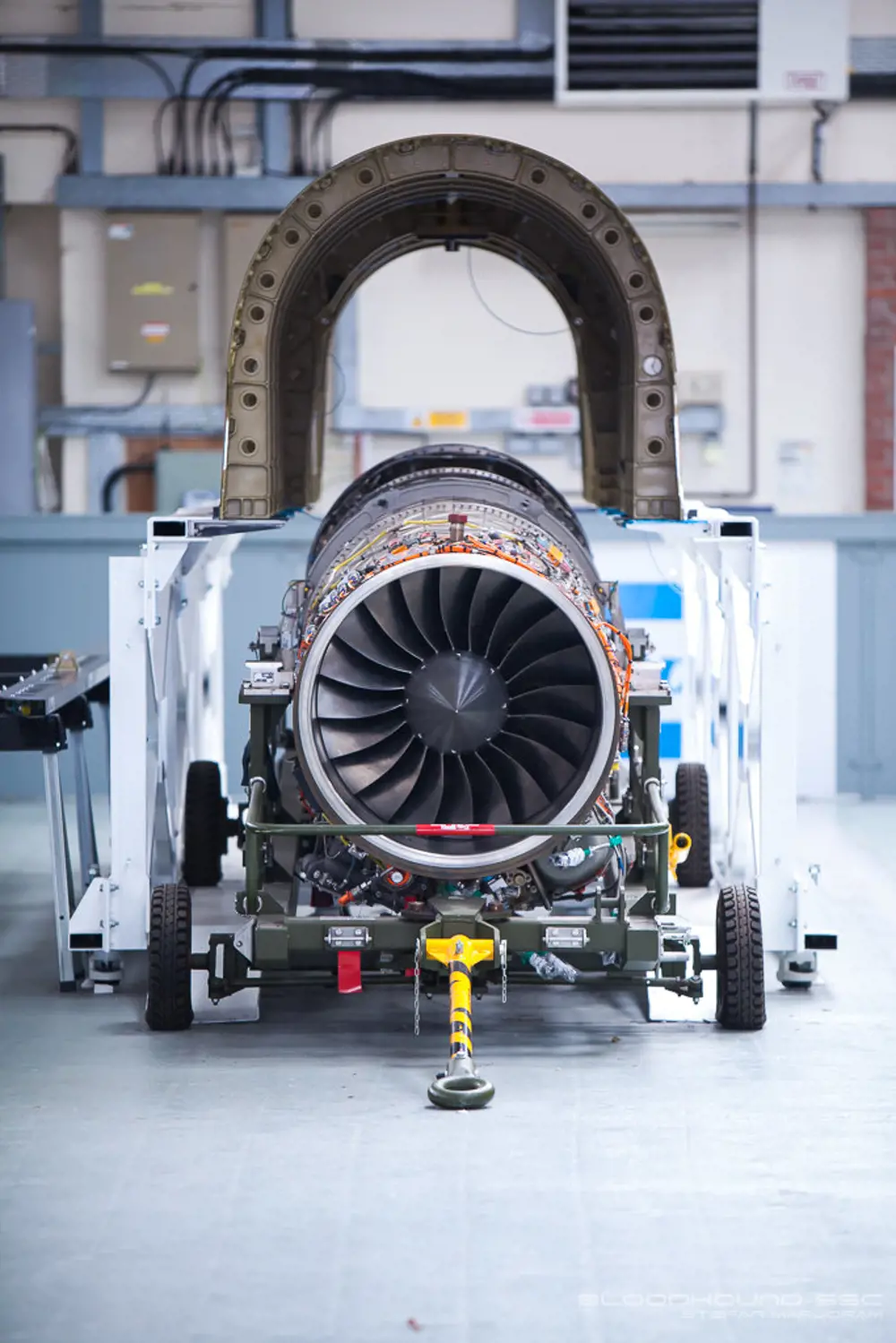
The Bloodhound was fitted with a jet engine designed for use in military fighter aircraft. This proved to be something of a challenge and resulted in changes to the shape of the car © Stefan Marjoram
Powered by jet engine
For those involved who have spent up to 10 years working on the project, hearing the engine’s reheat (afterburner) kick in for the first time was a visceral moment. The tests have provided some important answers that were needed before Bloodhound can be sent to South Africa for its first world record attempt in 2018.
Chief among these is the low speed capability of the jet engine intake mounted above the cockpit. Bloodhound is like a jet fighter with no wings, getting around half of its thrust from a Eurofighter Typhoon’s EJ200 jet engine.
On the Typhoon, this military turbofan engine is designed to work best at speeds of over 1,300 kph when air is rushing through it. At full power, it would be able to suck all the air out of an average house in around three seconds. However, at lower speeds, the jet engine intake may not get enough air into the engine to combust all the fuel at full throttle. Therefore, the team needed to test how it would perform at very low speeds to know when full power could be applied.
At full power, it would be able to suck all the air out of an average house in around three seconds
Before the test runs in Newquay, the engine was not expected to be able to cope with full power until the car reached around 130 kph. This was what the team had learned from the two Rolls-Royce Spey turbofans that had been used on the Thrust SSC. However, Green found that he could apply full power to the Bloodhound while stationary, which allowed the car to accelerate even faster than expected.
Fitting a jet engine, designed for a military fighter capable of flying at 1,550 kph, onto a car was no easy task. The EJ200 engine, which was provided by the Ministry of Defence, weighs nearly 1,000 kilograms and produces 90 kilonewtons (kN) of thrust. On an aircraft, the engine is set so that if it loses its connection with its control unit, it will continue operating so that the plane can stay in the air. In Bloodhound, this function needed to be circumvented to avoid the car from careering off into the desert. The team added a manually operated valve – operated by the sort of accelerator pedal you might find in a normal car – so that Green can manually shut off the jet engine’s fuel supply.
Jet engines are designed to work best at altitude. At ground level, Bloodhound will be travelling far faster than a Typhoon would on the ground, so it will push the engine to its limits. With this in mind, the air intake duct for the engine had to be specially designed to ensure a smooth stable flow. The original Bloodhound designs gave the car twin intake ducts, but airflow modelling revealed that this would create high levels of turbulence where the two ducts joined. Instead, the team changed the design so that a single, massive intake duct was positioned over the cockpit canopy.
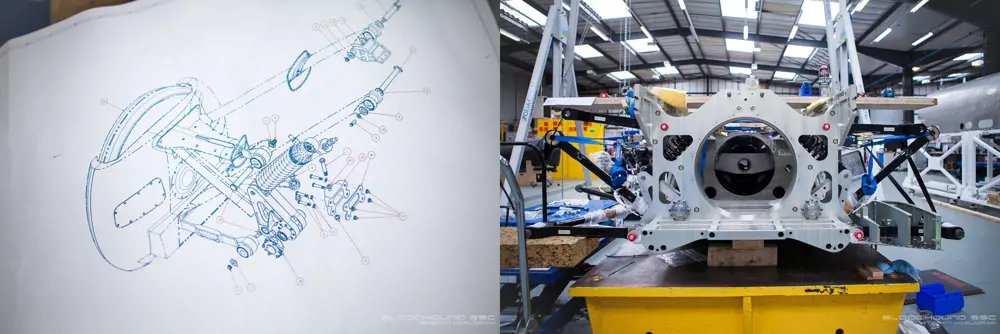
The rear end of the Bloodhound, including the suspension, had to be redesigned to cope with the extra weight from the cluster of three rockets that was added during development © Stefan Marjoram
This also led to changes to the overall shape of the car to ensure that the flow of air into the jet engine could be maintained. The engine itself cannot operate properly with air travelling into it above the speed of sound as this can cause shockwaves on its fan blades and cause it to choke. To overcome this, the shape of the cockpit canopy and the intake duct itself have been designed to slow down air to below supersonic speeds. A series of tiny shockwaves will be created as air passes over them, slowing the air from 1,600 kph to around 965 kph in under a metre.
However, the jet engine will only get the car up to a speed of 1,050 kph. To reach 1,600 kph, it will need some rocket power. Initially, Bloodhound was due to be powered by a single Falcon hybrid rocket, but in 2013 this was changed in favour of a cluster of three smaller rockets built by Norwegian company Nammo. These rockets will be added to the back of the vehicle for the record attempts.
Unfortunately, to accommodate this cluster of rockets, the rear end of the car, including the suspension, had to be redeveloped to cope with the extra weight. It was just one of the many challenges that the project has successfully tackled.
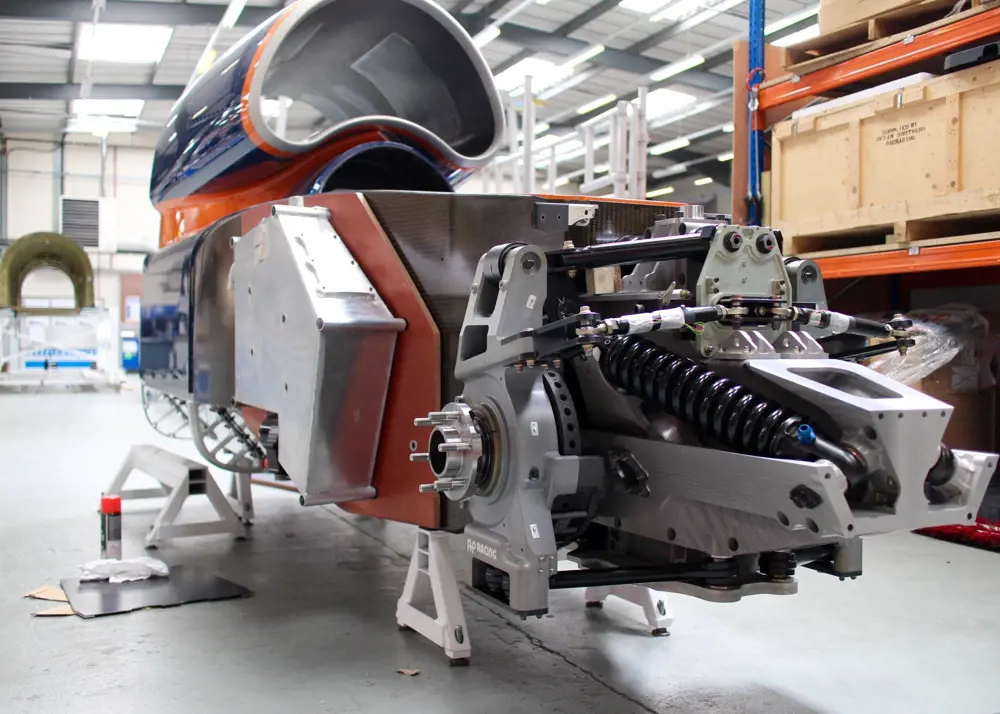
The Boodhound’s steering suspension joint is split and truncated, and the two parts move indepently of each other. This gives the best suspension stiffness and prevents the wheel from flexing off line, which can cause instability © Stefan Marjoram
Streamlining the design
The project was first announced in 2008, and has undergone much development. The goal was to have the Bloodhound running by 2012, but because it was such a major aerodynamic and engineering challenge, it took nearly three years to find the aerodynamic shape needed to keep the car safely on the ground at such high speeds.
Without access to expensive wind tunnels, the team was reliant upon sophisticated computer modelling to assess whether designs might work. One early tweak at the end of 2009 changed the configuration of the car so that the jet engine sat on top and the rocket underneath in an effort to reduce unwanted lift at the rear of the vehicle, and to simplify the design. However, aerodynamic tests suggested that this configuration could still lead to more than 100 kN of lift, which would be catastrophic for the car as it raced across the desert.
The team went back to the drawing board, but it was taking around 8 to 12 weeks to analyse each design model for its aerodynamic flow. With the help of some experts at analysis software producers MathWorks, the team introduced a new systematic way of assessing the data that allowed them to begin analysing designs in around 30 minutes. Within three months, it could produce what would remain broadly the final shape of the car. The key was minimising the rear wheel track width and the precise shape of the rear body of the car to ensure it would remain stable at high speeds.
The wheels have posed a particular problem for the Bloodhound team. During the test in Newquay, the vehicle was mounted on a set of four rubber tyres that were originally manufactured for the English Electric Lightning jet fighter; however, the car will need something far stronger when it is time for the record attempt. The difficulty lies in finding a material that is capable of withstanding more than 10,000 revolutions per minute and loads of 50,000 G at the wheel rim.
The difficulty lies in finding a material that is capable of withstanding more than 10,000 revolutions per minute and loads of 50,000 G at the wheel rim
A traditional wheel on a road car has a distinctive C-shape with the hub in the middle if you were to cut through it. This design helps to give cars responsive and predictable steering as the pivot point can be located inside the wheel hub at its centre. Unfortunately, at 1,600 kph, that C-shape cross-section begins to distort and break apart.
Instead, the Bloodhound team changed how the car was steered so that they could use a far simpler symmetric wheel, forged from solid disks of an aluminium-zinc alloy. These symmetric wheels rotate more like the fan from a gas turbine and spin tests at the Rolls-Royce facility in Derby demonstrated that they can easily cope with the loads they will face.
However, ensuring that these symmetric wheels still turn around their centre point meant using a different approach to steering. Road cars tend to use a traditional wishbone shape for the swivel joint that connects the wheel to the car. Bloodhound uses a suspension joint where the wishbone is split and truncated; these parts move independently to create what is known as a virtual steering axis. This allows the wheels to rotate about their centres as if the pivot point was located inside the wheel hub.
In a standard car, where a driver might want to turn the wheels up to 20 degrees while motoring along, a virtual steering assembly like this one would feel weird and not respond in ways that the driver might expect. However, at high speeds, Bloodhound will only need tiny adjustments to stay on course, so a whole rotation of the steering wheel from lock to lock will only turn the wheels about five degrees. It means that the car has an appalling turning circle of about 240 metres – Bloodhound is not the car to practise three-point turns in. Exactly how the steering performed in the real world only became clear during the tests in Newquay.
Green’s initial feedback was surprising: the car handled like it was driving along rails. Analysis of some of the data gathered during the test should reveal more about how the steering will perform at higher speeds.
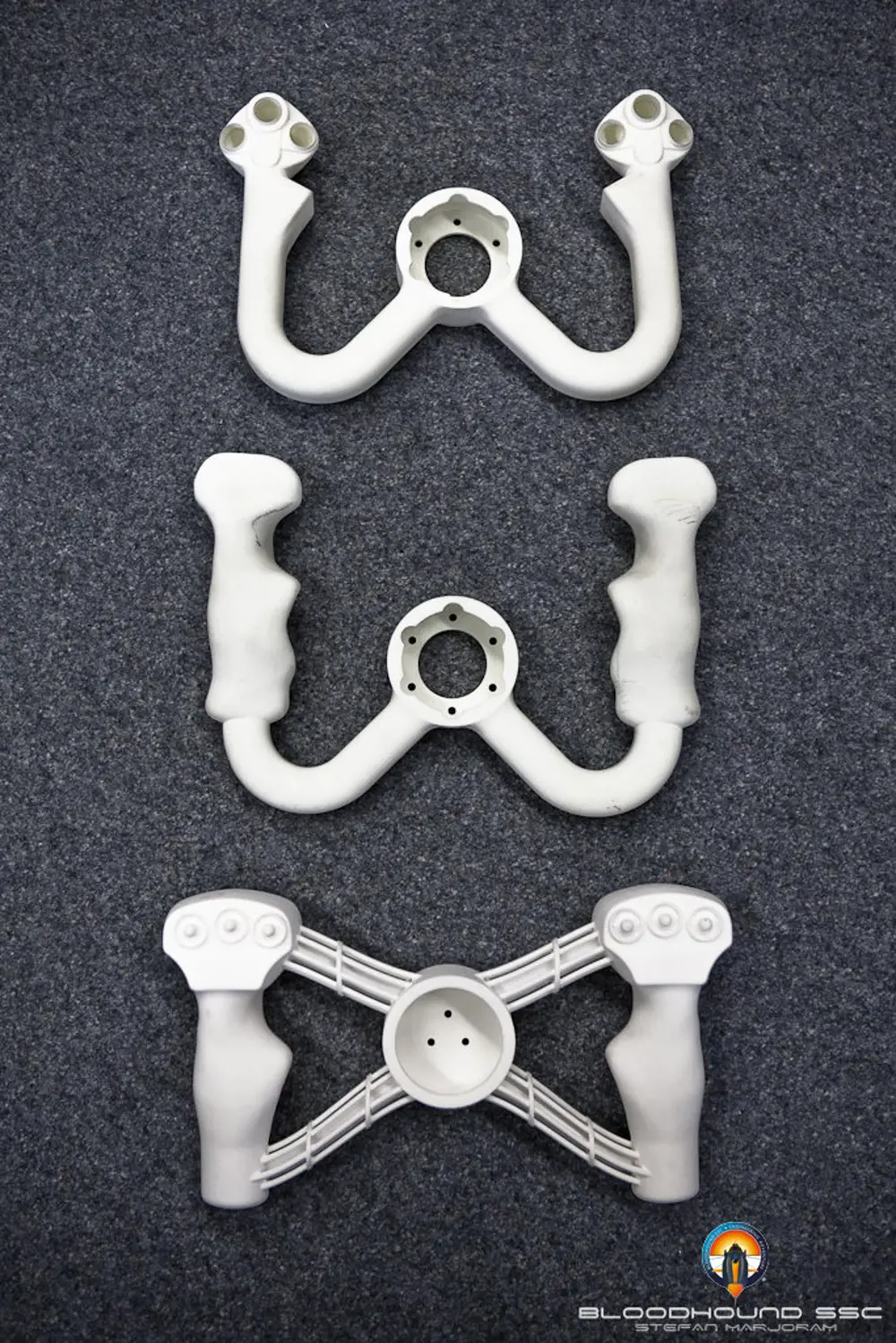
Prototypes of the Bloodhound’s steering wheel were 3D printed using moulds of driver Andy Green’s grip. The final design (bottom) was 3D printed in titanium by Renishaw © Stefan Marjoram
Creative thinking
The technical challenges faced when building a supersonic car able to break through the 1,600 kph barrier have brought unexpected hurdles, and issues with funding also led to some delays – as with many world record attempts across the globe. The team had hoped to travel to South Africa to attempt the world record in 2017, but a development hiatus last year to raise more funding saw the record attempt rescheduled until 2018.
So far, the development of Bloodhound has cost £30 million, and it is expected to cost a further £30 million to complete and run the vehicle for its record attempts. However, this £60 million price tag is a fraction of the cost of running a Formula One car for just one year – something that can cost the top teams up to £250 million annually.
These budget constraints have forced the Bloodhound team to think creatively about some of the solutions needed to build the car. A good example of this can be found with the car’s steering wheel, which has been 3D printed from titanium using moulds of Green’s grip as the basis. During the record attempts, the acceleration forces passing through Green’s arms to the wheel will reach up to 300 kilograms, which is why it needed to be made from metal.
During the record attempts, the acceleration forces passing through Green’s arms to the wheel will reach up to 300 kilograms, which is why it needed to be made from metal
To make controlling the vehicle’s systems easier when facing such high acceleration forces, the steering wheel also has three switches mounted on each side to fire the brake chutes, air brakes, radio and abort mission sequence. Two triggers on the back of the wheel control the firing of the rockets.
Rather than design its own triggers, or buy some from the space industry where they could cost thousands of pounds, the Bloodhound team looked at the electric power tools they were using. These devices are used every weekend by DIY enthusiasts in homes around the world, where they are exposed to damp, dust and vibrations, yet keep working. Costing just £8.99 each, installing a pair of triggers that are already used in power tools seemed like a neat solution to something that could have eaten up valuable time and money.
Similarly, the valving system on the rocket engines borrowed technology from the oil and gas industry rather than using expensive space industry components. The team modified high-pressure seals that are used on the shafts of high-speed machinery such as drills and found that they worked just as well in tests.
Inspiring through education
🏎️ How the Bloodhound project is encouraging more students into engineering
As well as breaking world records, inspiring the next generation of engineers and scientists is a major objective of the Bloodhound project. Alongside efforts to build the car, the Bloodhound team uses the details of its research, design and testing to run educational events and competitions.
In 2016 alone, more than 125,000 students in the UK participated in Bloodhound school workshops and other educational activities. This included a national rocket car championship, Race for the Line, which 4,000 schools participated in last year. Teams were challenged to build model rocket cars, which then competed at one of 120 regional race hubs. The winners then went on to race at regional and national finals over the summer.
Bloodhound also has a dedicated education team and volunteer ambassadors who visit schools to give presentations and hands-on demonstrations. At these, pupils learn about what it takes to build a 1,600 kph car and get to build their own rocket cars that they can race in the playground. Teachers can also use educational packs to help use Bloodhound to deliver parts of the STEM curriculum.
Over the next year, Bloodhound will also team up with Oracle Academy to provide two themed projects that will help students learn data analysis and Java programming skills, which will be available to classrooms and computing clubs in 120 countries around the world and will potentially inspire up to 3.5 million students.
While it is hard to measure the success of much of the educational outreach of the project, two of the universities that worked closely with Bloodhound, helping with airflow modelling, have seen the number of students applying for engineering courses rise since the project started. The University of the West of England has seen the number of engineering students at the university double since 2008, while Swansea University has seen the number of applications for aerospace engineering increase by more than two and a half times in the past five years.
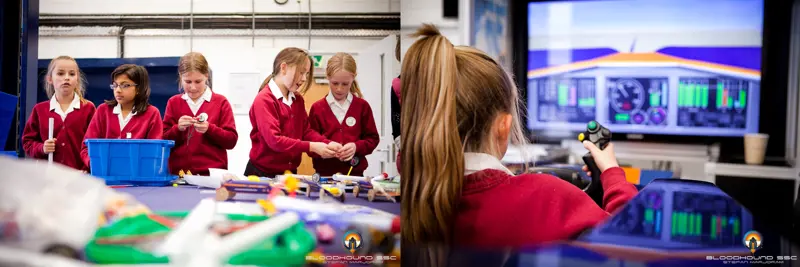
(Left) Students build their own model rocket cars at Bloodhound’s education centre in Bristol and (right) take part in a simulated driving experience © Stefan Marjoram
Set for South Africa
While the rockets themselves were not fitted to the car for Newquay, the two test runs have helped to reveal more information about how Bloodhound will perform that could not be obtained from computer models.
The car’s braking performance, for example, is a key deciding factor in how fast it will be able to go when it is taken out to the desert in South Africa for the record attempts. The car will hurtle across a huge dried-up lakebed called Hakskeenpan, in the arid north-west corner of the country.
An 18-kilometre-long track has been painstakingly cleared across the mud and salt flat, with more than 16,000 tonnes of stone removed by hand; but slowing the car down from around 1,600 kph could take between six and eight kilometres. Understanding how the air brakes and wheel brakes perform in the real world should help give a clearer idea of how much stopping distance the car will need, and how much space it will have to accelerate.
slowing the car down from around 1,600 kph could take between six and eight kilometres
The tests in Newquay have also allowed the Bloodhound team to get first-hand experience with the car, allowing the support crew to put the procedures they have been trained on into practice.
They have allowed Green to experience what the car will be like to drive: how the throttle and brake actions work, and how the steering responds. It has also given him an idea of the vibration and noise he might have to endure.
The sound levels produced by the jet engine, the cluster of rockets and the V8 engine that is being used to pump the rocket’s oxidiser fuel, are expected to generate more than 140 decibels. The car will begin to outrun its own soundwaves when it gets above 1,200 kph, but the shockwaves produced by the canopy and the jet intake are still expected to lead to noise levels of more than 120 decibels inside the cockpit.
The car will begin to outrun its own soundwaves when it gets above 1,200 kph, but the shockwaves produced by the canopy and the jet intake are still expected to lead to noise levels of more than 120 decibels inside the cockpit
The cockpit itself has been designed to protect Green not just from the noise, but also the risk of material being thrown up from the desert floor or off the wheels. It is surrounded by ballistic plates that have been tested by firing metal projectiles at them.
Although the front of Bloodhound is made from carbon fibre, it has been reinforced with an aluminium honeycomb so that it can withstand peak aerodynamic loads of up to 3,000 kilograms per square metre. The front is also protected by a 3D-printed titanium shield to help stop the dust thrown up by the car from eroding through the bottom.
Simply seeing a vehicle that is part high-performance race car, part jet fighter and part space rocket trundle out of its hangar at Newquay was a thrill for all those involved. Watching it race down the runway brought the record a step closer.
New lightweight battery technologies or even supercapacitors could make an electric motor a real option in ways that were not practical when the system was originally designed
Over the next year, the engineering team will be looking at new technologies that might improve the car even further. One of those will be to investigate using an electric motor to drive the pump that will push oxidiser into the rocket engines. Currently, the car has a Jaguar Supercharged V8 engine for the job, but an electric motor would be significantly smaller. New lightweight battery technologies or even supercapacitors could make an electric motor a real option in ways that were not practical when the system was originally designed.
Building a car that can travel faster than a bullet and is capable of crossing 4.5 football pitches laid end to end in a single second is an extreme challenge; at times, it has seemed like an almost impossible one. However, with Bloodhound now entering what feels like the final straight, it is hard not to feel just a little excited.
***
This article has been adapted from "Ready to break records", which originally appeared in the print edition of Ingenia 73 (December 2017)
Contributors
Richard Gray
Author
Mark Chapman began his career as an apprentice with British Aerospace, gaining a degree in aeronautical engineering from the University of Bath. He has worked on a huge variety of projects, from submarines and wave energy to spacecraft. In the five years before he joined the Bloodhound team, Mark was part of the team developing the F35B, the short take-off and vertical landing variant of the Joint Strike Fighter.
Keep up-to-date with Ingenia for free
SubscribeRelated content
Mechanical

When will cars drive themselves?
There are many claims made about the progress of autonomous vehicles and their imminent arrival on UK roads. What progress has been made and how have measures that have already been implemented increased automation?

R&D investment makes good business sense
In just five years, Dr Ralf Speth FREng has presided over a revolution in design and manufacturing that has helped create a new family of engines and has overhauled Jaguar Land Rover (JLR) production facilities.

Bikes help improve skills and attitude
The Archway Project is an independently-funded scheme that is expanding its engineering-based programmes by providing BTEC certificates and diplomas. John Milton, the director of the project, explains what the charity does to help reduce anti-social behaviour and improve employment prospects.

High speed evolution
In December 2010, Eurostar International Ltd awarded a contract for 10 new high speed trains to Siemens. The company has used a system developed over decades to maximise the performance and passenger-carrying ability of its 320km/h trains.
Other content from Ingenia
Quick read

- Environment & sustainability
- Opinion
A young engineer’s perspective on the good, the bad and the ugly of COP27

- Environment & sustainability
- Issue 95
How do we pay for net zero technologies?
Quick read

- Transport
- Mechanical
- How I got here
Electrifying trains and STEMAZING outreach

- Civil & structural
- Environment & sustainability
- Issue 95